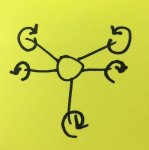Machdog314
Junior Member
I purchased the powerpack kit with the dragonfly. It came with 3 Red cap (CCW/Right threaded) motors and 2 Black cap (CW/Left threaded) motors. I have found conflicting information on the position of these motors. The included diagram was posted on another thread. It shows 3 props going CW and 2 going CCW, given the motors including in the kit I would think this would be reversed.
Can someone confirm the proper position of the motors?

Can someone confirm the proper position of the motors?

